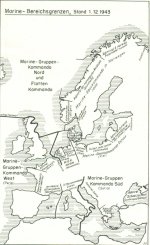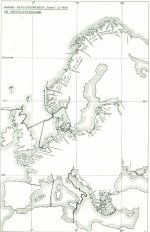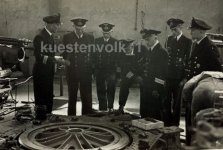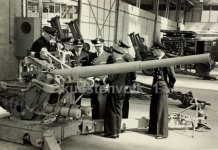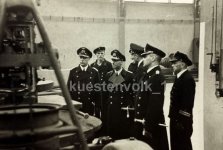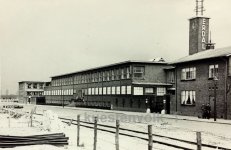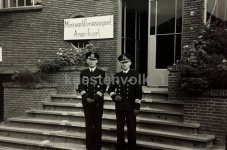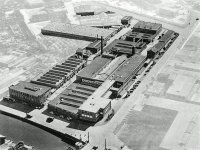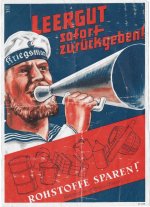I decided that I really needed to write up something on the Kriegsmarine depot system and how it was organized. This is perhaps less useful to us since the KM didn't do all that much with small arms, but I think its worth a quick read. Its also incomplete since there is less info out there on these than the others.
In 1919-1921, the Reichsmarine reestablished its depot system which included Marineartilleriedepots for arms and artillery. In 1935, names were changed and depots became Zeugämter:
Marineartilleriezeugamt (M.A.Za): The main equipment depots of the Kriegsmarine that were basically analogous to those of the Army.
Marineartillerienebenzeugamt (M.A.N.Za): Branch depots like the Army Nebenzeugämter.
Dienststelle des Marinesartilleriezeugamtes: These were apparently also branch offices of the main MAZa offices. I'm guessing these were similar to the MANZa, but probably much smaller.
In July 1943, these offices were renamed again to Marineartilleriearsenals. The Nebenzeugämter and Dienststelle appear to have been renamed Marineartilleriewaffenkommando (M.Art.Wa.Ko.), which served the same function (branch depots) but were now independent of the local Marineartilleriearsenal. Within Germany, all of the depots were subordinated to the Inspektion der Marinezeugämter (later renamed Artillerieinspektion). Depots outside the borders of Germany were subordinated to the local naval command (Kommandanten der Seeverteidigung), though the Inspektion still held technical control.
The following list is probably not definitive, I'm probably missing some especially in occupied countries where information is scarce. I am also not going to try to differentiate MANZa or the other branch depots from one another in the list. It would just get confusing as changes from one to another happened over time. They all seemed to serve more or less the same function, and all seem to have become Waffenkommandos by the end of 1943 anyway, so I am lumping them all together for clarity. Given how relatively small the Kriegsmarine was, the number of depots is somewhat shocking, though a lot of these were probably quite small.
Germany:
M.A.Za/M.Art.Ars:
Wilhelmshaven-Mariensiel
Aurich-Tannenhausen (upgraded from MANZa attached to Wilhelmshaven in 1942)
Emden (upgraded from MANZa attached to Wilhelmshaven in 1942)
Borkum (downgraded in 1942 to an Artilleriewaffenkommando and attached to MAZa Wilhelmshaven)
Helgoland (upgraded in 1938 from a MANZa subordinate to MAZa Wilhelmshaven to a full MAZa )
Hülsen (Aller) (downgraded in 1942 to a Dienststelle attached to Wilhelmshaven)
Cuxhaven
Brunsbüttelkoog (upgraded from Dienststelle to a MANZa attached to Cuxhaven in 1936, upgraded again to full MAZa in 1942)
Sylt (upgraded in 1936 from a MANZa subordinate to MAZa Cuxhaven)
Swinemünde
Pillau
Memel (upgraded in 1941 from Dienststelle subordinated to MAZa Pillau to full MAZa)
Gotenhafen
Jessenitz (Mecklenburg)
Kiel-Dietrichsdorf
Segeberg-Fahrenkrug (upgraded from MANZa attached to Kiel in 1939)
Linz-Ebelsberg (created in 1939 but dissolved one year later)
M.A.N.Za/Dienststelle/M.Art.Wa.Ko.:
Wangerooge
Norderney
Saßnitz
Travemünde
Flensburg
Husum
Wesermünde
Borkum
Lamspringe
Walldorf (Baden)
Hülsen (Aller)
Depots in the occupied countries
Netherlands
M.A.Za/M.Art.Ars:
Den Hagg, later Amersfoort (moved in 1943)
Veenendaal
Harlingen
M.A.N.Za/Dienststelle/M.Art.Wa.Ko:
Bergen op Zoom
Den Helder
France
M.A.Za/M.Art.Ars:
Brest
Boulogne
Brest
Lorient
St. Nazaire
Rochefort
Cherbourg (also Nordfrankreich)
Sète
Le Harve?
Guernsey?
M.A.N.Za/Dienststelle/M.Art.Wa.Ko:
Brügge (Belgium)
Guethary
Ostland
M.A.Za/M.Art.Ars:
Reval (Tallinn, Estonia)
M.A.N.Za/Dienststelle/M.Art.Wa.Ko:
Libau (Liepāja, Latvia)
Denmark
M.A.Za/M.Art.Ars:
Kopenhagen
Thisted
M.A.N.Za/Dienststelle/M.Art.Wa.Ko:
Esbjerg
Frederikshavn
Norway
M.A.Za/M.Art.Ars:
Horten
Oslo (downgraded to Art.Wa.Ko in 1943, subordinate to Horton)
Narvik
Tromsö
Kirkenes
Kristiansand-Süd
Bergen
Drontheim
M.A.N.Za/Dienststelle/M.Art.Wa.Ko:
Stavanger
Molde
Sandnessjöen
Norway fun facts: 1) MAZa/Art.Wa.Ko Oslo is where the Kongsberg M1914s and probably Krags were delivered 1941-1945. 2) Feldzeugstab Nord based in the Akershus Fortress in Oslo was the Army's primary equipment depot in Norway and received those Kongsberg weapons going to the Army.
Greece
M.A.Za/M.Art.Ars:
Salamis
Athen
M.A.N.Za/Dienststelle/M.Art.Wa.Ko:
Suda (Crete)
Rumania/Black Sea
M.A.Za/M.Art.Ars:
Kostanza (Constanța, Rumania)
Sewastopol? (Sevastopol, Soviet Union)
Kertch? (Kerch, Soviet Union)
M.A.N.Za/Dienststelle/M.Art.Wa.Ko:
Nikolajew (Nikolaev, Soviet Ukraine)
There were also Sperrzeugamts (for mines and related blocking equipment) that followed the same general structure of the MAZa, as well as other specialized depots. I'm not even getting into all of those. In July 1942, five Torpedoarsenals (West, Mitte, Ost, Atlantik, and Norwegen) were also created from the various Torpedoressort units.
In 1919-1921, the Reichsmarine reestablished its depot system which included Marineartilleriedepots for arms and artillery. In 1935, names were changed and depots became Zeugämter:
Marineartilleriezeugamt (M.A.Za): The main equipment depots of the Kriegsmarine that were basically analogous to those of the Army.
Marineartillerienebenzeugamt (M.A.N.Za): Branch depots like the Army Nebenzeugämter.
Dienststelle des Marinesartilleriezeugamtes: These were apparently also branch offices of the main MAZa offices. I'm guessing these were similar to the MANZa, but probably much smaller.
In July 1943, these offices were renamed again to Marineartilleriearsenals. The Nebenzeugämter and Dienststelle appear to have been renamed Marineartilleriewaffenkommando (M.Art.Wa.Ko.), which served the same function (branch depots) but were now independent of the local Marineartilleriearsenal. Within Germany, all of the depots were subordinated to the Inspektion der Marinezeugämter (later renamed Artillerieinspektion). Depots outside the borders of Germany were subordinated to the local naval command (Kommandanten der Seeverteidigung), though the Inspektion still held technical control.
The following list is probably not definitive, I'm probably missing some especially in occupied countries where information is scarce. I am also not going to try to differentiate MANZa or the other branch depots from one another in the list. It would just get confusing as changes from one to another happened over time. They all seemed to serve more or less the same function, and all seem to have become Waffenkommandos by the end of 1943 anyway, so I am lumping them all together for clarity. Given how relatively small the Kriegsmarine was, the number of depots is somewhat shocking, though a lot of these were probably quite small.
Germany:
M.A.Za/M.Art.Ars:
Wilhelmshaven-Mariensiel
Aurich-Tannenhausen (upgraded from MANZa attached to Wilhelmshaven in 1942)
Emden (upgraded from MANZa attached to Wilhelmshaven in 1942)
Borkum (downgraded in 1942 to an Artilleriewaffenkommando and attached to MAZa Wilhelmshaven)
Helgoland (upgraded in 1938 from a MANZa subordinate to MAZa Wilhelmshaven to a full MAZa )
Hülsen (Aller) (downgraded in 1942 to a Dienststelle attached to Wilhelmshaven)
Cuxhaven
Brunsbüttelkoog (upgraded from Dienststelle to a MANZa attached to Cuxhaven in 1936, upgraded again to full MAZa in 1942)
Sylt (upgraded in 1936 from a MANZa subordinate to MAZa Cuxhaven)
Swinemünde
Pillau
Memel (upgraded in 1941 from Dienststelle subordinated to MAZa Pillau to full MAZa)
Gotenhafen
Jessenitz (Mecklenburg)
Kiel-Dietrichsdorf
Segeberg-Fahrenkrug (upgraded from MANZa attached to Kiel in 1939)
Linz-Ebelsberg (created in 1939 but dissolved one year later)
M.A.N.Za/Dienststelle/M.Art.Wa.Ko.:
Wangerooge
Norderney
Saßnitz
Travemünde
Flensburg
Husum
Wesermünde
Borkum
Lamspringe
Walldorf (Baden)
Hülsen (Aller)
Depots in the occupied countries
Netherlands
M.A.Za/M.Art.Ars:
Den Hagg, later Amersfoort (moved in 1943)
Veenendaal
Harlingen
M.A.N.Za/Dienststelle/M.Art.Wa.Ko:
Bergen op Zoom
Den Helder
France
M.A.Za/M.Art.Ars:
Brest
Boulogne
Brest
Lorient
St. Nazaire
Rochefort
Cherbourg (also Nordfrankreich)
Sète
Le Harve?
Guernsey?
M.A.N.Za/Dienststelle/M.Art.Wa.Ko:
Brügge (Belgium)
Guethary
Ostland
M.A.Za/M.Art.Ars:
Reval (Tallinn, Estonia)
M.A.N.Za/Dienststelle/M.Art.Wa.Ko:
Libau (Liepāja, Latvia)
Denmark
M.A.Za/M.Art.Ars:
Kopenhagen
Thisted
M.A.N.Za/Dienststelle/M.Art.Wa.Ko:
Esbjerg
Frederikshavn
Norway
M.A.Za/M.Art.Ars:
Horten
Oslo (downgraded to Art.Wa.Ko in 1943, subordinate to Horton)
Narvik
Tromsö
Kirkenes
Kristiansand-Süd
Bergen
Drontheim
M.A.N.Za/Dienststelle/M.Art.Wa.Ko:
Stavanger
Molde
Sandnessjöen
Norway fun facts: 1) MAZa/Art.Wa.Ko Oslo is where the Kongsberg M1914s and probably Krags were delivered 1941-1945. 2) Feldzeugstab Nord based in the Akershus Fortress in Oslo was the Army's primary equipment depot in Norway and received those Kongsberg weapons going to the Army.
Greece
M.A.Za/M.Art.Ars:
Salamis
Athen
M.A.N.Za/Dienststelle/M.Art.Wa.Ko:
Suda (Crete)
Rumania/Black Sea
M.A.Za/M.Art.Ars:
Kostanza (Constanța, Rumania)
Sewastopol? (Sevastopol, Soviet Union)
Kertch? (Kerch, Soviet Union)
M.A.N.Za/Dienststelle/M.Art.Wa.Ko:
Nikolajew (Nikolaev, Soviet Ukraine)
There were also Sperrzeugamts (for mines and related blocking equipment) that followed the same general structure of the MAZa, as well as other specialized depots. I'm not even getting into all of those. In July 1942, five Torpedoarsenals (West, Mitte, Ost, Atlantik, and Norwegen) were also created from the various Torpedoressort units.
Last edited:



